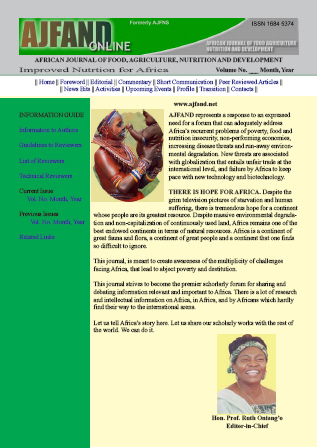
|
African Journal of Food, Agriculture, Nutrition and Development
Rural Outreach Program
ISSN: 1684-5358
EISSN: 1684-5358
Vol. 5, No. 1, 2005
|
 Bioline Code: nd05013
Bioline Code: nd05013
Full paper language: English
Document type: Research Article
Document available free of charge
|
|
|
African Journal of Food, Agriculture, Nutrition and Development, Vol. 5, No. 1, 2005
| fr |
Ponka R, Fokou E, Fotso M, Achu MB and FM Tchouanguep
Résumé
Dans le cadre général de la valorisation des aliments camerounais prêts à la consommation, trois plats alimentaires sont étudiés du point de vue de leurs protocoles de cuisson, de leurs valeurs nutritionnelles et des quantités de protéine, d'énergie et de minéraux qu'ils apportent aux consommateurs. Le "Corn chaff" est un mélange de maïs ( Zea mays

L.), de haricot ( Phaseolus vulgaris

) et d'huile de palme ( Elaeis guinensis

). Le "Nnam Owondo/Ebobolo" est un plat composé à base de pâte d'arachide ( Arachis hypogaea

) et de pâte de tubercule de manioc ( Manihot utilisima

). Le"Nnam Ngon/Ebobolo" est un plat composé à base de pâte de graines de courge ( Cucumeropsis mannii

) et de pâte de tubercule de manioc ( Manihot utilissima). La teneur en eau, cendre, protéine, lipide, fibre et glucide est déterminée par les méthodes standards. Les minéraux (magnésium, cuivre, fer et zinc) par spectrophotométrie d'absorption atomique. L'enquête auprès des vendeuses a donné les quantités d'aliments vendues actuellement sur le marché pour chacun des plats : 641,7g (200F CFA); 566,7 g (150F CFA) et 507,8 g (150F CFA) respectivement pour le "Corn chaff", le "Nnam Owondo /Ebobolo" et le "Nnam Ngon/Ebobolo". Les analyses ont donné les teneurs en principes nutritifs suivantes: eau (67,9; 49,5 et 53,4 g/100g M.F), cendre (4,30; 1,77 et 1,54 g/100g M.S), protide (11,7; 8,96 et 7,36 g/100g M.S), lipide (17,6; 13,5 et 7,79 g/100g M.S), fibre brute (3,18; 1,86 et 0,84 g/100g M.S), glucide (63,3; 73,9 et 82,5 g/100g M.S), magnésium (95,0; 108,1; 97,9 mg/100g M.S), cuivre (0,58; 0,27; 0,24 mg/100g M.S), fer (6,08; 2,99; 3,87 mg/100g M.S), zinc (3,74; 3,29; 3,14 mg/100g M.S) respectivement pour le "Corn chaff", le "Nnam Owondo/Ebobolo" et "Nnam Ngon/Ebobolo". Les taux de couverture des apports journaliers pour les adultes modérément actifs sont les suivants: protides (64,8; 69,3 et 45,7 %), énergie (31,4; 42,9 et 33,8%), magnésium (16,3; 25,9; 19,3%), cuivre (11,8; 7,70; 5,50), fer (6,9; 4,7; 5,1), zinc (12,8; 15,7; 12,4) respectivement pour le "Corn chaff", le "Nnam Owondo/Ebobolo" et le "Nnam Ngon/Ebobolo".
Mots Clés
Plats camerounais, préparation, apports nutritionnels.
|
| |
| en |
METHODS OF PREPARATION AND THE ENERGY, PROTEIN AND MINERAL VALUES OF THREE CAMEROONIAN DISHES: "CORN CHAFF", "NNAM OWONDO/EBOBOLO" AND "NNAM NGON/EBOBOLO"
Ponka R, Fokou E, Fotso M, Achu MB and FM Tchouanguep
Abstract
This study analyses the different methods of preparation and the nutritional value of three Cameroonian dishes. These are: "Corn chaff", "Nnam Owondo/Ebobolo" and "Nnam Ngon/Ebobolo". "Corn chaff" is a mixture of corn ( Zea mays

L.), beans ( Phaseolus vulgaris

) and palm oil ( Elaeis guinensis

). "Nnam Owondo/Ebobolo" is made up of groundnut paste ( Arachis hypogaea

) and cassava paste ( Manihot utilisima

)."Nnam Ngon/Ebobolo" is made up of egusi paste ( Cucumeropsis mannii

) and cassava paste ( Manihot utilisima). The moisture, ash, protein, lipid, fibre and carbohydrate contents were determined using standard methods. The mineral contents (magnesium, copper, iron and zinc) were determined by Atomic Absorption Spectrophotometry. A survey of these dishes in the market gave the quantity and the cost of each dish sold: A serving of "Corn chaff" which costs 200F CFA, weighs 641g; that of "Nnam Owondo/Ebobolo" which costs 150F CFA weighs 566g and that of"Nnam Ngon/Ebobolo" which costs 150F CFA weighs 507g. The proximate analysis gave the following nutritive content: moisture (67.9; 49.5 and 53.4 g/100g F.W), ash (4.30; 1.77 and 1.54 g/100g D.W), protein (11.7; 8.96 and 7.36 g/100g D.W), lipid (17.6; 13.5 and 7.79 g/100g D.W), fibre (3.18; 1.86 and 0.84 g/100g D.W), carbohydrate (63.3; 73.8 and 82.5 g/100g D.W), magnesium (95; 108.9 and 97.9 mg/100g D.W), copper (0.57; 0.27 and 0.23 mg/100g D.W), iron (6.08; 2.97 and 3,87 mg/100g D.W) and zinc (3.74; 3,29 and 3,14 mg/100g D.W) for "Corn chaff", "Nnam Owondo/Ebobolo" and "Nnam Ngon/Ebobolo" respectively. The content in nutrients shows that "Corn chaff" is balanced with respect to the proportions of protein, lipid and carbohydrate energy. On the other hand, "Nnam Owondo/Ebobolo" and "Nnam Ngon/Ebobolo" have low proportions of protein and lipid energy. The contents in minerals (Mg, Cu, Fe, and Zn) are low. The quantities actually ingested enable the coverage of 64; 69 and 45 % of the protein allowances and 31; 42 and 33% of the energy allowances for the tree dishes respectively, for an averagely active adult. For a good nutritional balance, it is recommended to consume a greater quantity of "Nnam Owondo " and "Nnam Ngon with smaller quantities of "Ebobolo".
Keywords
Cameroonian dishes, preparation, nutritional value.
|
| |
© Copyright 2005 - Rural Outreach Program
Alternative site location: http://www.ajfand.net/
|
|
